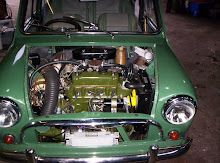When the contact-breaker points have been reassembled correctly the gap should be adjusted. The projection on the fibre block must be exactly on the crest of one of the "humps" of the cam. A slight movement of the cam in either direction will give a false reading—hence the recommendation that adjustment is best carried out with the contact-breaker on the bench.
The screw that retains the fixed-contact plate should be slackened and the plate moved by inserting a screwdriver blade in the notch in its edge and turning it clockwise to reduce the gap or anti-clockwise to increase it. After tightening the securing screw the gap should be rechecked.
The correct gap between the points is 0-014-0-016 in. (14 to 16 thou-sandths of an inch); a 0015-in. feeler gauge should just slide between them. It is, perhaps, worth mentioning that these gaps are appreciably greater than the gap of 0010-0012 in. specified for Lucas contact-breakers fitted to pre-1952 British cars. If the points should be inadver¬tently set to the latter gap the cITect would be to retard the ignition timing, causing loss of power and increased fuel consumption.
Changing the gap by even a few thousandths of an inch can alter the ignition timing by several degrees, and modern high-cfliciency engines are very sensitive to even slight changes in timing. It is advisable, therefore, after cleaning and adjusting the contact-breaker points or fitting a set of new points, to check the timing as described on pages 92-6. In most cases only a slight readjustment should be necessary.
Sunday, 11 October 2009
Adjusting Contact-breaker Gap
Posted by Info Mini Cars at 11:57
Subscribe to:
Post Comments (Atom)


0 comments:
Post a Comment